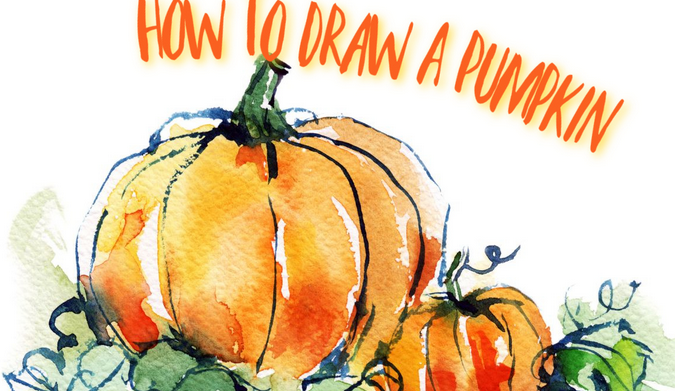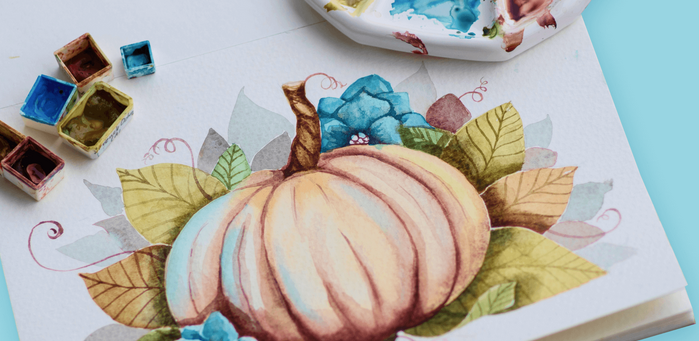Pumpkin drawing isn’t just a creative pastime; it’s a valuable learning experience for children. In this article, we’ll delve into the wonderful world of pumpkin drawing and explore the myriad benefits it offers young artists.

Introduction: A Colorful Journey Begins
Pumpkin drawing, with its vibrant orange hues and endless possibilities, beckons children into the world of art and imagination. This creative pursuit not only sparks their artistic spirit but also nurtures essential skills and qualities.
1. Enhanced Fine Motor Skills
Pumpkin drawing requires precision. As children grip pencils or crayons and carefully craft each line and curve, they’re honing their fine motor skills. These refined movements contribute to improved dexterity, setting a strong foundation for future activities like writing and crafting.
2. Visual Observation Skills
Creating a pumpkin drawing involves observing details, such as the pumpkin’s shape, ridges, and stem. This process cultivates children’s visual observation skills, encouraging them to pay attention to the world around them and appreciate subtleties they might have overlooked before.
3. Creative Expression
Drawing pumpkins isn’t just about replicating an image; it’s about expressing creativity. Children can give their pumpkins unique faces, colours, and personalities. This freedom fosters creativity, encouraging them to think outside the box and trust their artistic instincts.
4. Enhanced Concentration
The intricate nature of pumpkin drawings demands focus and concentration. Kids learn to pay attention to details, follow steps, and stay engaged in the creative process. These skills are transferable to other aspects of their academic and personal lives.
5. Boost in Confidence
Completing a pumpkin drawing, especially when it turns out beautifully, gives children a sense of accomplishment. They gain confidence in their abilities, which can positively impact their overall self-esteem and willingness to take on new challenges.
6. Cultural Awareness
Pumpkins hold cultural significance, particularly during fall and Halloween. Incorporating a brief lesson about the cultural importance of pumpkins while drawing can broaden a child’s understanding of traditions and celebrations.
7. Bonding Time
Pumpkin drawing can be a delightful family activity. Parents, grandparents, or siblings can join in, creating an opportunity for quality bonding time. Sharing the joy of drawing fosters stronger family connections.
8. Stress Reduction
Artistic activities, including drawing pumpkins, can serve as stress relievers for children. Engaging in art allows them to channel their emotions and frustrations in a constructive and calming manner.
9. Improved Communication
For some children, expressing emotions verbally can be challenging. Through their drawings, they can communicate thoughts, feelings, and experiences more comfortably. This can be particularly beneficial for kids who find it difficult to articulate their emotions.
10. Critical Thinking
Creating a pumpkin drawing involves making choices about colours, shapes, and details. Children need to think critically about how they want their pumpkins to appear, encouraging problem-solving and decision-making skills.
11. Enhanced Patience
Pumpkin drawing can be a patient endeavour, especially when children aim for intricate details or shading effects. This patience is a valuable trait that can extend to other areas of their lives, such as schoolwork and problem-solving.
12. Appreciation for Nature
Drawing pumpkins often leads to discussions about the natural world. Children might become more curious about plants, agriculture, and the changing seasons, fostering a deeper appreciation for nature and the environment.
13. Introduction to Artistic Techniques
While drawing pumpkins, kids may experiment with various techniques like blending colours, shading, and cross-hatching. These early art experiences lay the groundwork for more advanced artistic skills and techniques in the future.
14. Development of Storytelling Skills
Children can turn their pumpkin drawings into stories. They might imagine where their pumpkin character lives, what adventures they embark on, and who their pumpkin friends are. This imaginative storytelling can improve their narrative skills.
15. Cultural Exploration
Pumpkin drawing can be an opportunity to explore different cultures and their culinary traditions, broadening a child’s global awareness.
16. Spatial Awareness
Drawing requires children to understand proportions and spatial relationships. As they draw their pumpkins, they’ll develop a better sense of how objects fit together in a space.
17. Hand-Eye Coordination
Pumpkin drawing, like any art form, strengthens hand-eye coordination. This skill is crucial in many daily activities, from playing sports to typing on a keyboard.
18. Sense of Achievement
Completing a pumpkin drawing, whether it’s their first attempt or a more advanced project, instils a sense of achievement. This feeling of success encourages children to tackle new challenges with confidence.
19. Positive Emotional Outlet
Drawing allows children to express their emotions visually. When they’re feeling happy, sad, or excited, they can channel these feelings into their artwork, providing a healthy emotional outlet.
20. Lifelong Hobby
Introducing children to pumpkin drawing can spark a lifelong love for art. Many artists discovered their passion for creativity at a young age, and nurturing this interest can lead to a fulfilling hobby or even a career.
Conclusion
In conclusion, pumpkin drawing is more than a colourful artistic pursuit; it’s an enriching experience for children’s development. As they grasp pencils, observe details, and express their creativity, they’re building a foundation of skills and qualities that will serve them well throughout their lives. So, let’s encourage young artists to pick up their pencils and draw their way into a world of possibilities.

